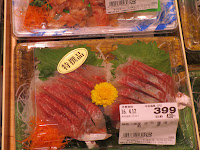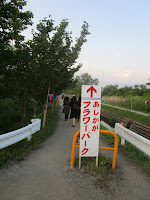One of the charming things about Japan is its attentiveness to the changing of the seasons. In America fashions only seamed to follow seasons enough for fashionistas to accuse something of being "so last season". In contrast, seasons in Japan are observed so that the things that people eat and wear are reflections and reminders of the weather outside my window. Winter, summer, autumn, and spring each have their own palates, decorations, colors, and clothing. Of course, one of the hardest parts of seasonality is the brevity of each. As foods and fashions change with the season, so a delicious flavor will only be available for a couple weeks before it is packed away till the next year to make way for a new treat.

Perhaps tho most astonishing and transient of these seasons is お花見 or cherry blossom viewing season. Japan is famous for its cherry trees. It is depicted in manga, in paintings, and it was even the state gift to America after the World War. Now I understand why the Japanese culture is so obsessed with this flower. The trees bloom at the first of spring - they are the first spring flowers to fully bloom (before tulips or daffodils) and the small (2" diameter) flowers coat each tree in the tens of thousands. The trees are clouds of cotton candy pink for a few days and then the petals fall. One at a time the five petals of each flower are caught up by the spring wind and twist and twirl their way to earth where they become a soft blanket on the ground. As the petals fall, friends and families often gather together for a picnic under the beautiful trees. お花見 O-hana-mi picnics feature delicious (seasonal) foods, 桜 sakura (cherry blossom) flavored desserts, good wine, and lasting memories.

It is difficult to stand in the soft sweetness of cherry blossoms, a flurry of pink petals whirling through the air and coating the ground, without a sense of wonder and excitement and a thanks to God. Their beauty is made more stunning by the fact that the life of a sakura flower is only 10-14 days from initial bloom to final fall. The Japanese government even rejected a genetically altered, longer lasting bloom because it detracted from their temporal beauty. Because there are so few days to take in the beauty, it is important to enjoy every day. Pink lanterns are even hung for nighttime viewing of the trees.

The Sakura River flows through the heart of Mito (pictured above) and over half a mile of the river is lined on either side with cherry trees. For two weeks that is where I ate my lunch and walked and thought. To describe the sensation of sitting below an avenue of cherry tree in bloom, it is like taking a deep breath, closing your eyes, sensing the wind toss and blow your hair, and feeling-for just one moment-that responsibilities have no power over you.
Below is a wedding couple in traditional kimono during cherry blossom season.
I also like the highly seasonal cherry blossom flavor. It it sweet and floral but so faint - it could never be an An american flavor because it is only a hint of a taste (just like the real smell of cherry blossoms). Somehow the natural faintness of the flavor makes it better, I think. Cherry blossom scents and flavors in America are smothering by comparison.
Below is a tree with a sign that says "mother of cherry trees." It is, perhaps, not the oldest cherry tree, but it is still a very old one. You can see the green leaves on this tree because the flowers have bloomed and fallen and the new leaves are growing for the new year.





























































